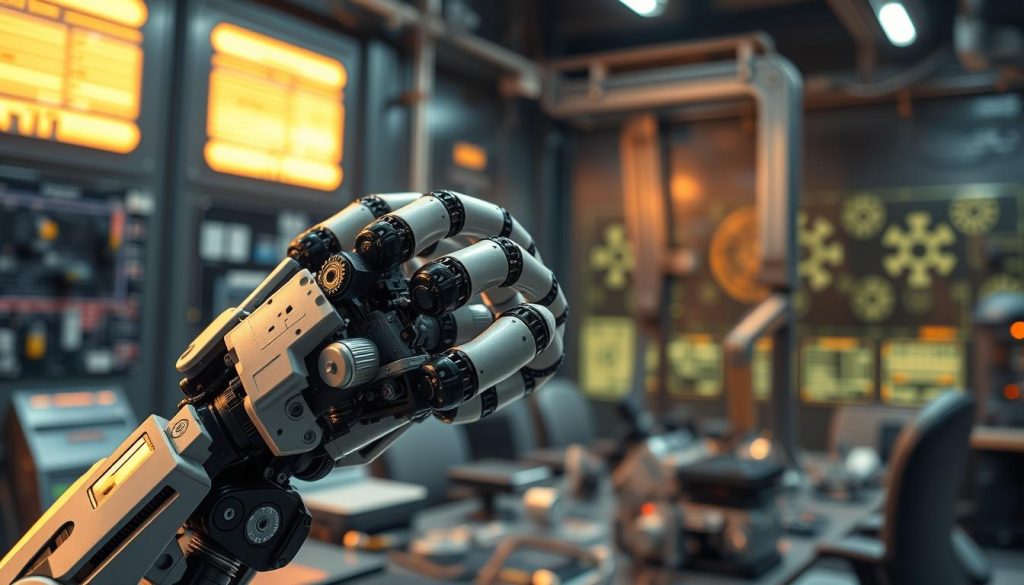Need specialized help with your robotics project? A freelance robotics engineer offers expert solutions without the overhead of a full-time hire. These professionals bring specialized skills to your work, delivering tailored engineering solutions.
Industries like manufacturing and healthcare increasingly rely on robotics for innovation. These experts handle everything from AI navigation systems to industrial robotic arms. Their design and development skills can accelerate your project timeline.
Platforms show exceptional satisfaction rates for these specialists. This approach provides cost-effective access to top-tier engineering talent. You get focused expertise exactly when you need it.
Table of Contents
Key Takeaways
- Freelance robotics engineers provide flexible, specialized expertise for various projects
- High client satisfaction rates demonstrate reliable service quality
- Cost-effective alternative to maintaining full-time engineering staff
- Accelerate project development and reduce time-to-market
- Skills span mechanical engineering, computer science, and electronics
- Ideal for industries like manufacturing, healthcare, and automation
- Platforms offer access to vetted professionals with proven track records
What is a Freelance Robotics Engineer?
Independent robotics specialists bring project-based expertise to complex technological challenges. These professionals operate as independent contractors rather than permanent employees. They offer specialized services for specific robotics initiatives.
This approach allows companies to access top talent without long-term commitments. The flexibility benefits both the specialist and the client. Projects can range from short-term consultations to complete system development.
The interdisciplinary nature of robotics engineering
Robotics represents a truly interdisciplinary field. It combines mechanical engineering, computer science, and electronics. This blend creates unique challenges and opportunities.
Specialists must understand how physical components interact with software systems. They work with sensors, actuators, and control systems simultaneously. This requires broad technical knowledge across multiple domains.
« The best robotics solutions emerge when mechanical, electronic, and software expertise converge seamlessly. »
Tasks might include robot design, AI integration, or system optimization. Each project demands different combinations of these skills. The interdisciplinary background enables comprehensive problem-solving.
How specialists differ from in-house robotics engineers
Contract-based professionals offer distinct advantages over permanent staff. They bring diverse experience from multiple projects and industries. This exposure to different challenges enhances their problem-solving abilities.
Companies gain flexibility without long-term financial commitments. They can scale teams up or down based on project needs. This is particularly valuable for companies in France exploring robotics initiatives.
These specialists often work remotely, reducing overhead costs. They typically manage their own equipment and software licenses. Clients pay only for the specific expertise and time required.
The growing demand for specialized robotics expertise
Advancements in AI, IoT, and automation drive increased need for specialized skills. Industries from healthcare to manufacturing seek robotics solutions. The pace of technological change accelerates this demand.
Platforms like Freelancer.com show numerous successful projects. These include medical devices, autonomous vehicles, and industrial automation systems. The variety demonstrates the breadth of applications.
Many specialists hold advanced degrees in relevant fields. They often possess PhD or master’s level training. Programming skills in Python, C++, and other languages are common.
The global nature of this field means expertise is available worldwide. Companies can access talent from India, Australia, the United States, and beyond. This creates opportunities for international collaboration.
Niche skills like computer vision or embedded systems become accessible without full-time hires. Organizations can tackle specialized projects that would otherwise require extensive training. This accelerates innovation and problem-solving.
Rest assured that reputable platforms vet these professionals thoroughly. They maintain proven track records and client satisfaction metrics. You can trust their expertise for your important projects.
These independent specialists drive innovation across multiple sectors. They solve complex problems that require interdisciplinary approaches. Their value extends beyond immediate project completion to long-term technological advancement.
Why Hire a Freelance Robotics Engineer?
Contract technical professionals deliver focused expertise that accelerates innovation timelines. They bring specialized knowledge exactly when you need it most. This approach transforms how companies approach complex technical challenges.

Cost-effective solutions for specific project needs
Engaging specialized talent on a contract basis offers significant financial advantages. Rates typically range from $16 to $200 per hour depending on expertise level. This provides substantial savings compared to full-time employee costs.
Companies can choose between fixed-price or hourly billing structures. Fixed-price arrangements work well for defined scope projects. Hourly billing offers flexibility for evolving requirements.
Real-world examples demonstrate this affordability clearly. A wearable robotic tail prototype recently completed for just $1,000. Motor housing design projects often budget around $250.
Access to specialized skills without long-term commitment
Contract professionals bring niche expertise without recruitment overhead. They possess skills in AI integration, control systems, and specialized software. This knowledge comes from diverse project experience across multiple industries.
Businesses can test innovative concepts before committing to in-house development. This reduces risk while exploring new technological applications. The freelance sector shows rapid growth in technical specialties.
You gain access to global talent pools with varied experience. These experts often hold advanced degrees in relevant fields. Their programming skills include Python, C++, and other essential languages.
Flexibility in project scaling and timeline management
Contract collaboration allows dynamic team sizing based on project phases. You can scale up during intensive development periods. Scale down during testing or documentation phases.
This approach significantly reduces time-to-market for new products. Professionals focus on specific milestones with dedicated attention. They adapt quickly to changing requirements and unexpected challenges.
Remote collaboration enables work across different time zones. This can accelerate progress through round-the-clock development. Clear contracts and milestone-based payments ensure risk mitigation.
| Cost Factor | Contract Professional | Full-Time Employee |
|---|---|---|
| Hourly Rate Range | $16 – $200 | $45 – $150+ |
| Benefits Overhead | None | 20-30% of salary |
| Equipment/Software | Usually self-provided | Company provided |
| Recruitment Costs | Minimal | $5,000 – $20,000 |
| Project Flexibility | High | Limited |
These advantages make contract professionals ideal for innovation initiatives. They provide efficient solutions for specific technical challenges. Next, we’ll explore the key services these experts typically offer.
Key Services Offered by Robotics Engineering Freelancers
Specialized technical professionals provide comprehensive solutions that transform concepts into functional systems. Their diverse skill set covers the entire development lifecycle. You get access to cutting-edge capabilities without maintaining a full internal team.
Robotic system design and development
Experts handle everything from initial concept to detailed implementation. They create 3D models using advanced CAD software. Mechanical design ensures proper component integration and functionality.
Electronic systems design includes sensor selection and circuit board layout. Professionals consider power requirements and signal processing needs. They optimize designs for manufacturing and assembly processes.
Automation and control systems implementation
Specialists program PLCs for industrial automation applications. They develop IoT integrations for remote monitoring and control. System architecture ensures reliable operation in production environments.
Motion control programming enables precise robotic movements. Professionals implement safety protocols and emergency stop systems. They create user interfaces for operator interaction and monitoring.
AI and machine learning integration for robotics
Computer vision systems enable object recognition and navigation. Machine learning algorithms provide predictive maintenance capabilities. Autonomous decision-making systems adapt to changing environments.
Natural language processing allows voice command interaction. Professionals train neural networks for complex pattern recognition. They optimize algorithms for real-time performance on embedded hardware.
Prototyping and testing services
Experts build functional models using platforms like Raspberry Pi. They conduct stress tests to validate design robustness. Iterative refinement improves performance and reliability.
Environmental testing ensures operation under various conditions. Professionals document test results and performance metrics. They provide recommendations for design improvements and optimizations.
| Service Category | Key Activities | Common Tools & Technologies |
|---|---|---|
| System Design | 3D modeling, CAD work, component selection | SolidWorks, AutoCAD, Fusion 360 |
| Automation Control | PLC programming, IoT development, system integration | ROS, MATLAB, LabVIEW |
| AI Integration | Computer vision, predictive maintenance, autonomous systems | Python, TensorFlow, OpenCV |
| Prototyping | Functional modeling, stress testing, design iteration | Raspberry Pi, Arduino, 3D printing |
Real-world examples demonstrate these capabilities effectively. Professionals have developed AI-based visual navigation systems for autonomous vehicles. Self-balancing robot projects showcase control system expertise.
Space exploration assistance projects utilize SLAM tools for mapping. Industrial robotic arms improve manufacturing efficiency and precision. Medical device development requires compliance with strict safety standards.
These services combine mechanical, electrical, and software engineering disciplines. Cross-functional expertise ensures comprehensive solution development. Professionals stay current with industry standards and regulatory requirements.
The breadth of available options meets diverse project requirements. From simple prototypes to complex production systems, specialists deliver results. Your ideas become tangible products through professional implementation.
Essential Skills of Top Robotics Engineers
Successful robotics projects demand a diverse set of technical capabilities from skilled professionals. These specialists combine multiple disciplines to create innovative solutions. Their comprehensive background ensures they can handle complex technical challenges.

Top performers typically hold advanced degrees in relevant fields. Many possess PhD or master’s level training. This educational foundation supports their practical application of complex concepts.
Mechanical engineering fundamentals
Strong mechanical design skills form the foundation of quality robotics work. Professionals understand kinematics and dynamics for movement planning. They apply material science principles for durable construction.
These experts work with CAD software for precise component design. They consider manufacturing processes during the development phase. Material selection impacts both performance and cost efficiency.
Computer science and programming expertise
Programming knowledge is essential for bringing robotic systems to life. Specialists commonly use Python, C++, and ROS for algorithm development. These languages enable complex functionality implementation.
Software skills extend to simulation tools and machine learning frameworks. Professionals create efficient code for real-time system operation. Their programming background supports various automation applications.
Similar to other IT specialists, they work with data analysis and interpretation. This capability enhances machine learning integration and system optimization.
Electronics and embedded systems knowledge
Circuit design expertise enables proper component integration. Professionals select appropriate sensors for specific application requirements. They understand power management and signal processing needs.
Microcontroller experience includes platforms like Arduino and Raspberry Pi. These tools support prototyping and testing phases. Embedded systems knowledge ensures reliable hardware-software interaction.
Problem-solving and innovation capabilities
Creative thinking drives breakthrough solutions in complex projects. Specialists approach challenges with systematic analysis methods. They develop innovative approaches to technical obstacles.
Communication skills ensure clear collaboration with project teams. Project management abilities support timely delivery and quality outcomes. Continuous learning keeps professionals current with emerging technologies.
« The best solutions emerge when technical expertise meets creative problem-solving approach. »
Rates for these highly skilled professionals typically range from $50 to $200 per hour. This reflects their advanced education and specialized capabilities. Their diverse experience across multiple projects enhances their problem-solving ability.
These comprehensive skills prepare specialists for the hiring process we’ll discuss next. Their technical foundation supports successful project outcomes across various industries.
Finding the Right Freelance Robotics Engineer in France
France’s robotics sector offers exciting opportunities for specialized technical projects. The market combines industrial tradition with cutting-edge innovation across multiple fields. You can find excellent talent for your automation needs.
Key industries drive demand for advanced technical solutions. Automotive manufacturing requires precision automation systems. Aerospace applications need reliable robotic assistance.
Healthcare automation represents another growing field. Research institutions develop innovative medical devices. Each sector has specific technical requirements.
Understanding the French technical market landscape
France maintains strong industrial foundations while embracing new technology. Traditional manufacturing sectors modernize their operations. Emerging fields like medical devices show rapid growth.
The country’s academic system produces highly skilled professionals. Engineering schools rank among Europe’s best institutions. Research centers collaborate with industry partners.
This creates a rich ecosystem for technical innovation. Companies benefit from both established expertise and fresh ideas. The environment supports successful project development.
Local expertise vs. international experience considerations
Local professionals understand French regulations and standards. They know compliance requirements for specific industries. This knowledge helps avoid regulatory issues.
International specialists bring diverse project experience. They’ve worked across different markets and challenges. This broad perspective can inspire innovative solutions.
« The best collaborations blend local knowledge with global perspectives for outstanding results. »
Consider your project’s specific needs when choosing between local and international talent. Complex regulatory environments may favor local experts. Cutting-edge innovation might benefit from international experience.
Language and communication requirements for French projects
French language skills become important for certain project aspects. Client meetings often require local language proficiency. Technical documentation may need French translations.
Compliance paperwork typically uses official French templates. Team coordination benefits from shared language understanding. Clear communication ensures project success.
Many international professionals work effectively in English. Technical collaboration often uses universal terminology. Balance language needs with technical requirements.
Platforms like Freelancer.com show professionals serving French clients. Rates remain competitive with global standards. You can find excellent value for your investment.
- Cultural understanding improves collaboration effectiveness
- Local professionals may offer faster response times
- International talent brings diverse project experience
- Language flexibility depends on specific project needs
- Review checking ensures quality and reliability
France’s growing technical market offers numerous opportunities for innovation. The strong academic system produces skilled professionals. Research institutions provide cutting-edge knowledge.
Evaluate candidates based on their portfolio quality and relevant experience. Consider both local and global options for your specific needs. The right choice depends on your project’s unique requirements.
Remote work enables hiring international specialists while local professionals offer convenience. Check reviews and ratings to ensure quality service. This approach helps find the perfect match for your technical project.
Types of Robotics Projects You Can Outsource
Many companies benefit from outsourcing specialized technical work. This approach allows access to diverse skills without expanding internal teams. You can tackle various initiatives with external talent.
Projects range from simple prototypes to complex production systems. Budgets vary widely based on scope and complexity. You can find options matching your specific needs.
Industrial automation and manufacturing systems
Manufacturing facilities often seek automation improvements. Specialists design conveyor systems for efficient material handling. They program robotic arms for precise assembly tasks.
These projects reduce human error and increase production speed. Quality control systems ensure consistent output. Professionals integrate sensors for real-time monitoring.
« Automation transforms manufacturing by combining precision with relentless efficiency. »
Industrial applications require robust safety features. Experts implement emergency stop protocols. They ensure compliance with industry regulations.
Autonomous vehicle and drone development
Navigation algorithms enable self-guided movement. Specialists integrate various sensors for environmental awareness. They develop control systems for stable flight.
Drone projects often involve aerial photography or delivery applications. Ground vehicles might handle warehouse logistics. Each system requires customized programming.
Real-time data processing supports decision-making. Professionals optimize algorithms for performance. They test systems in various conditions.
Medical robotics and assistive devices
Healthcare applications demand extreme precision. Surgical robots require flawless operation. Assistive devices help people with mobility challenges.
These projects follow strict regulatory guidelines. Specialists ensure patient safety through rigorous testing. They document all development processes thoroughly.
Recent examples include wearable robotic tails for balance assistance. Prosthetic limbs incorporate advanced control systems. Each application serves specific medical needs.
Research and development initiatives
Exploratory projects push technological boundaries. Space exploration tools use advanced mapping techniques. New materials undergo extensive testing.
AI research develops smarter machine learning approaches. Professionals experiment with novel control methods. They document findings for future applications.
These initiatives often involve academic collaboration. Teams combine theoretical knowledge with practical implementation. Results contribute to overall field advancement.
| Project Type | Typical Budget Range | Key Technologies | Common Applications |
|---|---|---|---|
| Industrial Automation | $5,000 – $100,000 | PLC, ROS, CAD | Assembly lines, packaging |
| Autonomous Systems | $1,000 – $50,000 | LIDAR, Python, SLAM | Drones, warehouse robots |
| Medical Devices | $2,000 – $75,000 | Precision sensors, C++ | Surgical assistants, prosthetics |
| Research Projects | $500 – $30,000 | AI frameworks, MATLAB | Space exploration, AI research |
Outsourcing accommodates various project scales. Small Arduino-based prototypes might cost under $1,000. Large industrial systems can approach $100,000.
Collaboration often involves multiple specialists. Data scientists might work on machine learning components. Mechanical experts handle physical design elements.
Clearly defining your project scope ensures better outcomes. Specify your technical requirements upfront. This helps specialists understand your vision completely.
Whether you need a simple prototype or full production support, external talent can help. Their diverse experience brings fresh perspectives to your work. You can achieve remarkable results through strategic partnerships.
The Hiring Process: From Brief to Collaboration
Finding the right specialist for your technical project involves a structured approach. A clear process helps ensure successful outcomes and builds strong working relationships. This guide walks you through each step with practical advice.
Defining your project requirements clearly
Start by creating a detailed project brief. Include technical specifications, deadlines, and budget constraints. This clarity helps specialists understand your needs accurately.
Be specific about required technologies and programming languages. Examples might include « CUDA optimization » or « ROS development. » Clear requirements lead to better proposals and accurate pricing.
Consider your project’s scope and complexity. Break larger initiatives into manageable phases. This approach helps specialists provide realistic timelines and cost estimates.
Screening and evaluating candidate portfolios
Review each candidate’s previous work and client feedback. Look for experience with similar projects and technologies. This evaluation ensures technical compatibility.
Check for relevant certifications and educational background. Many platforms provide rating systems and verified skill assessments. These tools help identify qualified professionals.
Conduct interviews to assess communication skills and cultural fit. Discuss their approach to problem-solving and project management. This conversation reveals their working style and expertise.
« The right match combines technical capability with collaborative spirit for project success. »
Establishing milestones and communication protocols
Create a phased delivery schedule with clear milestones. This structure enables progress tracking and quality assurance. Regular checkpoints keep projects on schedule.
Set up communication channels using project management tools. Establish response time expectations and meeting schedules. Consistent communication prevents misunderstandings.
Platforms often provide built-in features for secure collaboration. These include NDAs and intellectual property protection agreements. Such measures ensure confidentiality and security.
| Process Step | Key Activities | Best Practices |
|---|---|---|
| Project Definition | Technical specs, budget setting, timeline planning | Include examples of required technologies |
| Candidate Screening | Portfolio review, skill verification, interview conducting | Check for similar project experience |
| Agreement Setup | Contract drafting, milestone setting, communication planning | Use platform security features |
| Collaboration Management | Progress tracking, issue resolution, quality assurance | Regular status updates |
Data shows that professionals with complete profiles receive three times more client requests. Clear project definitions help avoid inappropriate proposals. This careful approach leads to better matches.
Many companies find excellent project opportunities through structured hiring processes. They build relationships with reliable specialists for ongoing needs. This method supports long-term innovation and growth.
A well-organized hiring process reduces risks and increases success rates. It ensures you find the right expertise for your specific requirements. This foundation supports productive collaborations and outstanding results.
Budgeting for Your Robotics Project
Smart budget planning makes your technical work successful and stress-free. Good financial management ensures you get quality output without overspending. Let’s explore how to structure costs for your specific needs.

Understanding rate structures in robotics
Specialists offer different pricing models for their services. Hourly rates typically range from $20 to $150. This depends on their experience and your project complexity.
Fixed-price contracts work for well-defined deliverables. You might pay $1,000 for a complete prototype. Motor housing design could cost around $250.
These options give you flexibility based on your requirements. Complex systems might need hourly billing. Simple products often suit fixed pricing.
Fixed-price vs. hourly project considerations
Choose fixed-price when your scope is clear and detailed. This protects you from unexpected cost increases. It works best for projects with specific output expectations.
Hourly arrangements offer more flexibility for changes. They adapt well to evolving research or development needs. This model suits exploratory work where requirements might shift.
« The right pricing model matches your project’s certainty level – fixed for clear scope, hourly for evolving needs. »
Many platforms provide payment protection for both options. Funds release only after milestone completion. This ensures quality control throughout the process.
Budget allocation for different project phases
Divide your total budget across major development stages. Allocate approximately 30% for initial design work. This covers planning and technical specifications.
Development typically requires about 50% of your budget. This phase involves actual building and programming. Testing and iteration need the remaining 20%.
Always include contingency funds for unexpected challenges. Most experts recommend adding 10-15% buffer. This prevents budget overruns during complex work.
| Project Phase | Budget Allocation | Key Activities |
|---|---|---|
| Design | 30% | Planning, specifications, technical drawings |
| Development | 50% | Building, programming, integration |
| Testing | 20% | Quality checks, iterations, improvements |
Request detailed proposals from potential collaborators. Good plans break down costs for each phase clearly. This helps you understand where your money goes.
Consider the specialist’s location and experience level. These factors significantly impact final costs. More complex technology usually means higher prices.
Good budgeting leads to successful projects and positive outcomes. It ensures you get the expertise you need within your means. Next, we’ll see how proper planning delivers excellent results in real situations.
Success Stories: Real Projects Completed by Freelancers
Seeing real-world results builds confidence in technical partnerships. These success stories showcase what’s possible when skilled professionals tackle complex challenges. Each project demonstrates unique problem-solving approaches and technical excellence.
Independent specialists consistently deliver outstanding results across various industries. Their work transforms ideas into functional, innovative products. These achievements highlight the value of specialized expertise.
AI-based visual navigation systems development
A manufacturing company needed autonomous material handling vehicles. They hired a specialist with computer vision experience. The project required complex environment mapping and obstacle avoidance.
The professional developed machine learning algorithms for real-time decision making. Sensors provided continuous environmental data. The system learned to navigate dynamic warehouse environments safely.
« The navigation system reduced our operational costs by 40% while improving safety metrics significantly. »
This solution combined artificial intelligence with precise control systems. It demonstrated how advanced technology solves practical business challenges. The client reported exceptional satisfaction with the final product.
Industrial robotic arms for production automation
An automotive parts supplier sought to automate their assembly line. They needed customized robotic arms for precise component placement. The project demanded reliability under continuous operation conditions.
A specialist designed mechanical systems with integrated quality control sensors. Programming ensured smooth, coordinated movements. The arms worked seamlessly with existing production equipment.
Implementation reduced production errors by 75%. Output increased by 30% without additional staffing. The return on investment occurred within six months of operation.
Self-balancing robots using Raspberry Pi
A research institution required educational demonstration units. They wanted self-balancing robots for student projects. The challenge involved creating affordable, reliable teaching tools.
A professional integrated gyroscopic sensors with control algorithms. Raspberry Pi provided the computational power needed. The design used readily available components for easy replication.
Students gained hands-on experience with control systems and electronics. The project inspired many to pursue advanced studies in the field. It showed how simple technology can demonstrate complex principles.
Space exploration assistance using SLAM tools
A space research organization needed mapping capabilities for planetary exploration. They required systems that could operate in unknown environments. The project involved extreme reliability requirements.
Specialists developed simultaneous localization and mapping solutions. These systems created real-time maps while tracking their own position. The technology enabled autonomous exploration in challenging conditions.
This work contributed to important scientific research missions. It demonstrated how Earth-based technology advances space exploration. The collaboration produced valuable data for future missions.
| Project Type | Key Technologies | Business Impact | Client Rating |
|---|---|---|---|
| AI Navigation | Computer vision, machine learning | 40% cost reduction | 5/5 stars |
| Industrial Automation | Precision control, sensor integration | 30% production increase | 4.8/5 stars |
| Educational Robots | Raspberry Pi, control algorithms | Enhanced learning experience | 4.9/5 stars |
| Space Exploration | SLAM, autonomous systems | Advanced research capabilities | 5/5 stars |
These success stories illustrate the tangible benefits of technical partnerships. Each project addressed specific challenges with customized solutions. The results speak for themselves through improved efficiency and innovation.
Many clients establish ongoing relationships after successful initial projects. They value the consistent quality and specialized knowledge. This approach builds strong, productive long-term collaborations.
Platform reviews consistently highlight excellent communication and professional delivery. Clients appreciate the combination of technical skills and practical problem-solving. These partnerships drive innovation across multiple industries.
Your project could become the next success story. The right specialist brings the expertise and experience needed for outstanding results. These examples show what’s possible with the right technical partnership.
Building Long-Term Relationships with Robotics Experts
Strong partnerships with technical specialists create lasting value for innovative companies. These relationships extend beyond single projects into ongoing innovation cycles. They become strategic assets that drive continuous improvement.

The value of ongoing collaboration
Repeated work with the same experts brings significant advantages. They already understand your business goals and technical environment. This deep knowledge accelerates each new initiative.
Onboarding time reduces dramatically with familiar collaborators. They know your systems and preferences from previous experience. This efficiency translates into faster results and lower costs.
« The best innovations emerge from relationships built on trust and shared vision over time. »
These partnerships often lead to better rates and prioritized support. Specialists value reliable clients and offer favorable terms. Everyone benefits from sustained successful collaboration.
Scaling projects with trusted freelancers
Successful initial projects naturally lead to expanded opportunities. You can engage proven specialists for new development phases. They bring valuable continuity to complex initiatives.
Many companies build entire teams from previous collaborators. These groups work together seamlessly across multiple projects. Their shared experience creates exceptional synergy.
Platform data shows clients frequently rehire top performers. Some maintain relationships across dozens of successful projects. This approach scales expertise alongside business growth.
Creating innovation partnerships beyond single projects
The strongest relationships evolve into true innovation partnerships. Specialists contribute ideas and improvements beyond initial scope. They become thought partners in your technological advancement.
These collaborations can develop into advisory roles or co-development opportunities. Experts provide insights based on broad industry experience. Their external perspective often sparks breakthrough ideas.
Regular check-ins and feedback loops maintain alignment over time. Clear communication ensures everyone understands evolving goals and requirements. This ongoing dialogue fosters continuous improvement.
| Relationship Stage | Key Benefits | Typical Outcomes |
|---|---|---|
| Initial Project | Proven capabilities, understanding of needs | Successful delivery, established trust |
| Repeated Collaboration | Reduced onboarding, better rates | Faster results, cost efficiency |
| Innovation Partnership | Strategic input, co-development | Breakthrough solutions, competitive advantage |
Fair treatment and respect are essential for retaining top talent. Professionals appreciate clients who value their work and expertise. These positive relationships often last for years.
The right directory connects you with reliable experts for long-term success. You gain access to professionals who can grow with your needs. This approach builds a foundation for sustained innovation.
Investing in relationship-building pays dividends through better results and smoother processes. Your technical partners become extensions of your team. Together, you achieve more than possible through temporary arrangements.
Industry Trends Shaping Robotics Engineering
The field of robotics continues to evolve at an incredible pace. New technologies and approaches are transforming how we design and implement automated systems. Staying current with these developments helps companies maintain competitive advantages.
Advances in artificial intelligence and machine learning
Artificial intelligence brings new capabilities to automated systems. Machine learning enables robots to adapt to changing environments. They can learn from data and improve their performance over time.
These technologies allow for more complex decision-making. Robots can handle unexpected situations without human intervention. This flexibility opens new applications across various industries.
Specialists with AI background are in high demand. Their knowledge helps create smarter, more responsive systems. This expertise drives innovation in manufacturing, healthcare, and beyond.
Growing integration of IoT in robotic systems
The Internet of Things connects robots to broader networks. This integration enables coordinated operations across multiple devices. Systems can share data and work together seamlessly.
IoT connectivity supports remote monitoring and control. Operators can manage equipment from anywhere with internet access. This capability improves efficiency and reduces downtime.
Many recent projects involve IoT-based monitoring solutions. These systems collect valuable performance data for analysis. The information helps optimize operations and predict maintenance needs.
« Connected robotics systems represent the future of smart manufacturing and automated services. »
Sustainability and energy efficiency in robotics design
Environmental considerations now influence technical development. Designers focus on reducing energy consumption and material waste. Eco-friendly materials are becoming more common in new projects.
Energy-efficient designs lower operational costs significantly. They also reduce the environmental impact of automated systems. Many companies prioritize sustainability in their technology choices.
Some specialists work on renewable energy applications. These projects demonstrate how automation supports green initiatives. The combination of efficiency and environmental responsibility creates lasting value.
These trends impact hiring decisions across industries. Companies seek professionals with current knowledge and skills. The ability to work with emerging technologies provides competitive advantages.
Staying updated on industry developments ensures better project outcomes. It helps companies make informed decisions about their technology investments. The right expertise makes all the difference in successful implementation.
Why Choose Our Directory of Freelance Robotics Engineers
Our carefully selected directory connects you with top-tier robotics talent who have already proven their capabilities through rigorous screening processes. We handle the vetting so you can focus on finding the perfect match for your specific project requirements.
Curated network of vetted professionals
Every specialist in our directory undergoes comprehensive skill verification. We check their educational background and project history thoroughly. This ensures you access only qualified professionals.
Our screening process includes technical assessments and reference checks. We verify their experience with various robotics systems and programming languages. You get pre-qualified talent ready for immediate collaboration.
« The peace of mind knowing every candidate meets high standards makes project initiation much smoother. »
Security features include NDAs and intellectual property protection. These safeguards protect your innovative concepts throughout development. Secure payment options provide additional financial security.
Diverse expertise across robotics specialties
Our directory covers the entire spectrum of robotics applications. From medical device development to industrial automation systems. You find specialists for any technical challenge.
Artificial intelligence integration represents a particularly strong area. Many professionals hold advanced degrees in machine learning and computer vision. Their knowledge drives innovation in smart systems development.
Other specialty areas include autonomous vehicles and drone technology. Control systems programming and sensor integration expertise. Each specialist brings unique capabilities to your projects.
Proven track record of successful project delivery
Our professionals maintain exceptional client satisfaction ratings. The current average stands at 4.92 out of 5 stars. This reflects consistent quality and reliable performance.
Successful projects include drone development and AI navigation systems. Industrial control systems and medical device prototypes. Each accomplishment demonstrates practical problem-solving ability.
Client reviews highlight excellent communication and technical competence. Professionals deliver on time and within budget constraints. Their work ethic matches their technical skills.
| Selection Criteria | Our Directory Standards | Typical Market Standards |
|---|---|---|
| Skill Verification | Comprehensive technical testing | Basic profile review |
| Experience Level | Minimum 3 successful projects | Varies widely |
| Client Ratings | Minimum 4.5/5 stars | No minimum requirement |
| Security Features | Full IP protection included | Often additional cost |
| Response Time | Within 24 hours guaranteed | No time commitment |
Global talent pool includes both local and international options. French professionals understand regional regulations and standards. International specialists bring diverse perspective and innovative approaches.
Time savings compared to unstructured hiring are significant. Reduced risk comes from working with pre-vetted professionals. You avoid the uncertainty of traditional recruitment processes.
Browse detailed profiles and compare proposals with confidence. Each specialist’s portfolio showcases their capabilities clearly. Start your project knowing you have the right team.
Our directory serves as your one-stop solution for robotics engineering needs. From initial concept to final implementation support. We connect you with the expertise required for success.
Conclusion
Technical experts provide flexible solutions for specialized project needs. They bring deep knowledge across engineering and software domains.
Using a vetted directory ensures quality collaboration. You gain access to proven expertise without long searches.
Define your requirements clearly and budget smartly. This approach drives innovation while controlling costs.
Start your search today to accelerate development. Transform your ideas into successful products with the right solution.
FAQ
What exactly does a robotics engineer do?
These professionals design, build, and test robotic systems. They combine mechanical engineering, computer science, and electronics knowledge to create machines that perform tasks autonomously or with human guidance.
How can hiring a freelancer benefit my project?
You get specialized talent without the overhead of a full-time employee. It’s perfect for specific needs, offering flexibility in both timeline and budget while accessing top-tier skills.
What types of projects can I outsource?
From industrial automation and medical devices to autonomous vehicles and research initiatives. If it involves creating or improving robotic systems, there’s likely a specialist available.
What should I look for in a candidate’s portfolio?
Seek proven experience in your specific area—whether it’s AI integration, control systems, or mechanical design. Look for successful past projects that match your complexity and industry.
How are pricing structures typically set?
Many professionals offer both fixed-price and hourly arrangements. Fixed-price works well for defined projects, while hourly rates provide flexibility for evolving development needs.
Why choose a curated network of specialists?
You save time vetting candidates while ensuring quality. These networks connect you with pre-screened talent who have demonstrated successful project delivery across various specialties.





